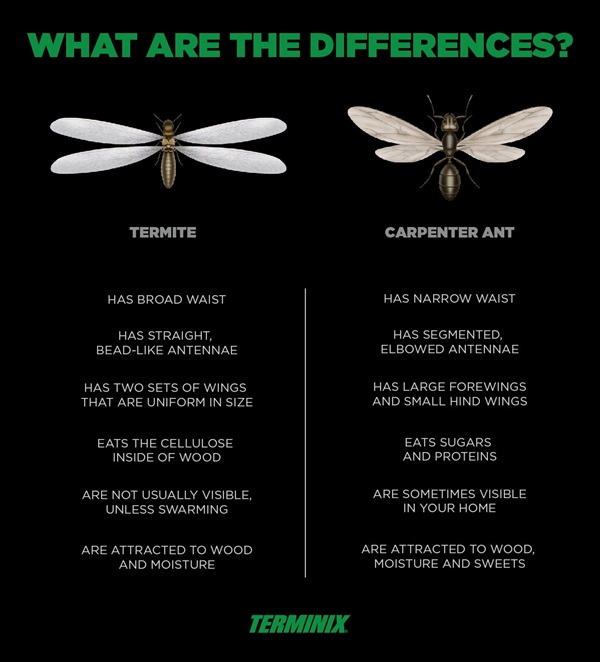Take a look at the differences between termites and ants, specifically carpenter ants.
Both ants and termites swarm when it's time for mating, and both are known for causing damage to wood. In fact, there are many species of ants that swarm and may be confused with termite swarmers. However, they have more differences than they do similarities. Keep reading to learn more about termites vs. ants.
And while many ant species swarm and have wings, we're going to focus on carpenter ants as they are more commonly confused with termites due to their wood-damaging tendencies.
How Can You Tell the Difference Between Termites and Ants?
Body Shape
One of the key differences between termites and ants is the shape of their bodies. Carpenter ants, along with other ants, have narrow "waists." Termites, on the other hand, have more broad "waists."
Antennae
Termite antennae are unique from those of ants because they look like little beads or balls, and are straight. Ant antennae are distinctly elbowed.
Wings
Remember that only reproductive carpenter ants and termites have wings and swarm from the colony. There are a couple of ways to tell them apart, though these identifiers may be difficult to see.
Both insects have two sets of wings. Termites' wings are pretty much uniform in size while ants have two large forewings and two smaller hind wings. Sometimes you may only find wings. And if they're all the same size then they are probably termite wings. If the wings are different sizes, then they are probably ant wings.
Diets
Termites are known for eating wooden structures because they need the cellulose within the wood to survive. Do carpenter ants eat wood? No. Rather they make their homes in the wood, excavating the shavings as they burrow further into structures. Unlike termites, carpenter ants' diets consist of other insects.
Visibility
A termite's habitat depends on the termite species. Unless you spot a swarm, you're more likely to spot signs of termites rather than the actual insects. Key signs that you have termites include discarded wings, mud tubes and wood damage for subterranean termites. Termite pellets, or "droppings," can be a sign of drywood termites. Carpenter ants, on the other hand, will venture out to forage for food, so you may actually see them in your home.
Attractants
Moisture in your home attracts both ants and termites. Naturally, they're also both attracted to wood and easy points of entry. However, that's where the list of what attracts carpenter ants and termites begins to deviate.
Another difference between termites and ants is that the carpenter ants don't eat wood (as mentioned above), so they'll be attracted to other sources of food, and may be seen wandering on window sills and baseboards.
Flying Ants vs Termites
Carpenter ants swarm when it's mating time. This means that you could see something resembling a flying ant. And that could be exactly what it is. Carpenter ants that are swarming do have wings and look similar to flying termites. But flying ants and flying termites have different body shapes, antennae and wings (see image above).
Can Termites be Mistaken for Ants?
Yes, termites can be mistaken for ants (and vice versa), especially when they're flying during a swarm. We've outlined some key differences in their appearances above, such as body shape, antennae and wings. But it can certainly be difficult spotting these differences. This is where a trained pest control professional can help.
If you think you have either pest in your home, contact Terminix®. A trained pest control professional can evaluate your problem and work with you to customize a control and prevention plan.




